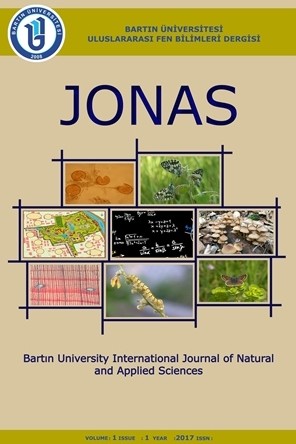COMPARATİVE ANALYSİS OF THE VİSUAL ELEMENTS OF TRADİTİONAL MOSQUES OVER MODERN MOSQUES
Mosque, traditional mosque, modern mosque, visual perception
COMPARATİVE ANALYSİS OF THE VİSUAL ELEMENTS OF TRADİTİONAL MOSQUES OVER MODERN MOSQUES
Mosque, traditional mosque, modern mosque, visual perception,
___
- 1. Akbulut, N. (2017). Türkiye’de Çağdaş Cami Mimarisi Tsarımında Yenilikçi Yaklaşımlar (C. 93, Sayı I). İstanbul Aydın Üniversitesi.
- 2. Altın, M. (2010). Pantheon’dan Günümüze Kubbelerin Gelişimi. Yalın Yayıncılık.
- 3. Ateş, İ. (1994). Mescid-i Nebevî’nin Yapıldığı Günden Bu Yana Geçirdiği Genişletme Girişimleri. Vakıflar Dergisi, 14(9 7 5-1 9-0 9 0 0-7), 6.
- 4. Burckhardt, T. (2009). İslam Sanatı Dil ve Anlam. Klasik Yayınları.
- 5. Cansever, T. (2005). Mimar Sinan. Klasik Yayınları.
- 6. Duman, S. (2015). Doğu-Batı Ayırımında Aslında Mimarlık, Şehircilik ve Sanat... Kaknüs Yayınları.
- 7. Dündar, A. (2018). Uluslararası Cami Sempozyumu (Sosyo-Kültürel Açıdan) BİLDİRİLER KİTABI I. CİLT. Içinde F. Karaman (Ed.), Fonksiyonu ve Mimari Unsurlarıyla Mescid-i Nebevi’nin İslam Sanatı ve Kültüründeki Yeri ve Önemi (ss. 8–9). İnönü Üniversitesi Yayınları No:39.
- 8. Duysak, N. (2000). 20. Yüzyıl Türkiye’sinde Cami Tasarımı Ve Geleneksel Cami. İstanbul Teknik Üniversitesi.
- 9. Fatih, K. (2011). Peygamberimiz Hz. Muhammed’in Müezzinleri. Ankara Üniversitesi İlahiyat Fakültesi Dergisi, 52(2), 291–310. https://doi.org/10.1501/ilhfak_0000001089
- 10. Garaudy, R. (2019). İslâm’ın Aynası Camiler. Timaş Yayınları.
- 11. Grabar, O. (1987). The Formation of Islamic Art. Yale University Press. https://doi.org/10.2307/600277
- 12. Hasol, D. (2008). Ansiklopedik Mimarlık Sözlüğü. Yapı Endüstri Merkezi Yayınları.
- 13. Hattstein, M., & Delius, P. (2004). Islam Art and Architecture. Könemann.
- 14. Hillenbrand, R. (2013). İslamic Art and Architecture. Thames & Hudson. https://doi.org/10.1057/9780230360341.0163
- 15. Kuban, D. (2007). Osmanlı Mimarisi (G. İpek (ed.)). Yapı Endüstri Merkezi Yayınları.
- 16. Necipoğlu, G. (2013). Sinan Çağı Osmanlı İmparatorluğu’nda Mimarî Kültür. İstanbul Bilgi Üniversitesi Yayınları.
- 17. Ökten, S. (2012). l Ulusal Cami Mimarisi Sempozyumu “Gelenekten Geleceğe Cami Mimarisinde Çağdaş Tasarım ve Teknolojiler”. Cami Üzerine Güncel Düşünceler, 143–147.
- 18. Salimi, A. (2013). İslam Ülkelerinde Çağdaş Cami Mimarisi Sorunsalı. Yakındoğu Üniversitesi Fen bilimleri Enstitüsü.
- 19. Stierlin, H. (2008). İmanın ve İktidarın Hizmetinde İSlam Mimarisi (Ç. A. Berkay (ed.); 2. baskı). Yapı Kredi Yayınları.
- 20. Sülün, M. (2020). Kur’an’dan San’ata. Diyanet İşleri Başkanlığı Yayınları.
- 21. Ülken, H. Z. (1948). İslam Sanatı. İTÜ Mimarlık Fakültesi Yayınları.
- 22. URL-1 (2022). “Mescid-i Nebevi” https://okuryazarim.com/mescid-i-nebevi/ (Accessed: 05 Feb 2022)
- 23. URL-2 (2022). “Discover İslamic Art: Madrasa and Mosque of Sultan Hasan https://islamicart.museumwnf.org/database_item.php?id=monument;isl;eg;mon01;16;en&cp (Accessed: 04 May 2022)
- 24. URL-3 (2022). “Avrupa'nın Göbeğinde Bir Doğu İncisi: Kurtuba Camii” https://wannart.com/icerik/19698-avrupanin-gobeginde-bir-dogu-incisi-kurtuba-camii (Accesses: 04 May 2022)
- 25. URL-4 (2022). “Bezmi Alem Valide Sultan Camii Fotoğrafları” http://mtgahlatt42.blogspot.com/2014/06/bezmi-alem-valide-sultan-camii.html (Accessed: 04 May 2022) 26. URL-5 (2022). “Üç Şerefeli Cami – Edirne” https://www.kulturportali.gov.tr/turkiye/edirne/gezilecekyer/uc-serefeli-cami (Accessed: 27 Apr 2022)
- 27. URL-6 (2022). “Okyanusun kıyısında, dünyanın en büyük ikinci camisi: II. Hasan Camii” https://www.gzt.com/arkitekt/okyanusun-kiyisinda-dunyanin-en-buyuk-ikinci-camisi-ii-hasan-camii-3561255 (Accessed: 24 Apr 2022)
- 28. URL-7 (2022). “Jami' al-Umawi al-Kabir (Damascus)” https://www.archnet.org/sites/31?media_content_id=131780 (Accessed:04 May 2022)
- 29. URL-8 (2022). “Mosquée du Cheikh Lutfallah / Masjid-i Sadr / Sheikh Lotf Allah Mosque / مسجد شیخ لطفالله - Ispahan / اصفهان“ http://www.albert-videt.eu/photographie/carnet-de-route/iran_10-2006/mosquee-cheikh-lutfallah_masjed-e-sheikh-lotf-o-llah_masjid-i-sadr_ispahan_00.php (Accessed: 04 May 2022)
- 30. URL-10 (2022). “Kılıç Ali Paşa Camii” https://www.mustafacambaz.com/details.php?image_id=32178 (Accessed: 04 May 2022)
- 31. Ülken, H. Z. (1948). İslam Sanatı. İTÜ Mimarlık Fakültesi
- Yayın Aralığı: Yılda 2 Sayı
- Başlangıç: 2017
- Yayıncı: Bartın Üniversitesi
YABAN HAYATI BESLEMESİ ÜZERİNE BİR DEĞERLENDİRME
Nuri Kaan ÖZKAZANÇ, Burak YİGİT
STADYUMLARIN KENTTEKİ SOSYAL YAPILANMASININ TÜRKİYE AÇISINDAN DEĞERLENDİRİLMESİ
SYNTHESIS AND FUNCTIONAL PROPERTIES OF DIPHENYLAMINE-CONTAINING SCHIFF BASES
Hasan Ufuk CELEBİOGLU, Ebru KÖROĞLU, Recep TAŞ, Sevilay GÜNAY, Yavuz ERDEN
KOMPOZİT ZIRH TASARIMI VE BALİSTİK DİRENCİNİN İNCELENMESİ
PERFORMANCE OF BORON NITRIDE NANOSHEETS IN DYE ADSORPTION: A MINI-REVIEW
COMPARATİVE ANALYSİS OF THE VİSUAL ELEMENTS OF TRADİTİONAL MOSQUES OVER MODERN MOSQUES
Esma KİŞMİROĞLU, Serhat ANIKTAR
KENT SİMGESİ KÜLTÜR MERKEZLERİNİN GÖRSEL ALGI ANALİZİ
Özlem KAHRAMAN, Serhat ANIKTAR
THE EFFECT OF PINE TREE RESIN ON THE THERMAL AND MECHANICAL PROPERTIES OF PLASTER WITH EXPANDED CLAY
DOMATESTE BULUNAN KAROTENOİDLERDEN OLAN LİKOPENİN PROBİYOTİK BAKTERİLER İLE ETKİLEŞİMLERİ
